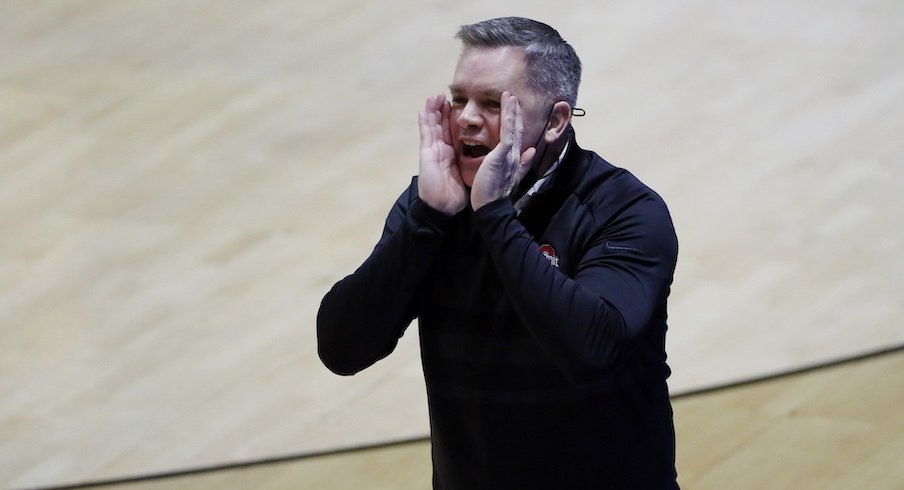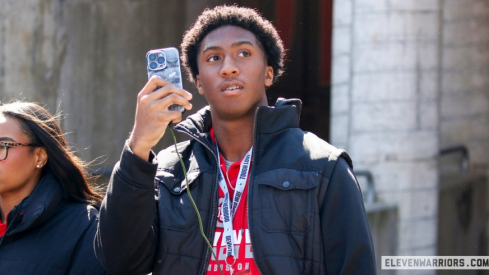The NCAA tournament draw, all things considered, set up pretty well for Ohio State.
In Round 1, the Buckeyes were matched up with a 16-10 Summit League team in Oral Roberts rated as the worst defensive team in the field of 68. Next up would be either Florida, which lost three of its prior four games, or Virginia Tech, which had a weeks-long COVID-19 pause in February and entered the tournament with a single win in five weeks. Arkansas or Texas Tech would’ve been awaiting them in the Sweet 16. Then, it might’ve been Baylor in the Elite Eight, meaning Ohio State avoided Gonzaga’s region.
By no means was this a “Group of Death.”
But the Buckeyes exited immediately anyway. They didn’t make it past the first day, becoming the first 2 seed to lose to a 15 seed since Tom Izzo’s Michigan State fell to Middle Tennessee in 2016. Oral Roberts got the better of them, 75-72, in overtime.
“This is obviously a really, really bitter end to a terrific season. We'll own that and accept it and,” said head coach Chris Holtmann who paused for eight seconds, “we'll move forward.”
That’s all he really could say on Friday in the aftermath of arguably the worst NCAA tournament loss in Ohio State history. All he could tell his team in an emotional locker room and all he could tell reporters an hour after the buzzer sounded.
This was a prime opportunity for the Buckeyes to advance further than they’d gotten in years. Not since 2013 had they made it beyond the second round of the NCAA tournament. That year, Thad Matta took Deshaun Thomas, Aaron Craft and others past Iona, Iowa State and Arizona to the Elite Eight where Wichita State ultimately eliminated them. Given the potential NCAA tournament path and the resume of this Ohio State team that led to it earning a 2 seed, it seemed as though the drought of March Madness success would – and, in the opinions of many, should – come to an end this month.
Instead, for the eighth time in eight years, the Buckeyes didn’t make it to the second weekend of the NCAA tournament. And for the fifth time during that stretch, they didn’t even make it to the second round.
So, as the fourth year of the Holtmann era wraps up, Ohio State’s drought of success in March continues.
“I think obviously that's the next step for us, there's no question, is finding a way to get to the second weekend,” Holtmann said. “I think in the previous couple years we were beaten by teams that were higher seeded than us, and we were able to upset a team there two years ago. So this has not happened to us in our (four) years together.”
Nobody, the head coach included, would hide the fact that the Buckeyes’ success rate in the tournament is, to this point, substandard. They have picked up two wins – both in the first round – in three tournaments.
In Holtmann’s first year, Ohio State beat South Dakota State as a 5 seed, taking care of business in the first round with an eight-point victory, before falling to Gonzaga in a six-point second-round loss. The next year, the Buckeyes snuck into the tournament as an 11 seed by patching together holes on what was unequivocally the least talented roster of Holtmann’s four years in Columbus. Somehow, some way, they knocked off an Iowa State team that had Sacramento Kings lottery pick Tyrese Haliburton and two other NBA players in the rotation, 62-59, in what remains one of the most impressive victories of the Holtmann era. They fell the next round, as expected, in a 15-point loss to Houston.
Holtmann contends his 2019-20 Ohio State team had the potential to make a run in the tournament his third year as head coach. He made that case right away and he has stuck to it, pointing out both the offense-defense balance – that this year's team lacked – and the strong play down the stretch to win nine of the last 12 games. But that’s easier to say when the games don’t get played, which is what happened, of course. His Buckeyes never got a shot to leave the faithful satisfied or disappointed. Abruptly, without much notice, the season ended with the Big Ten and NCAA canceling their respective tournaments.
So, that left Holtmann to enter Year 4 still searching for a Sweet 16 berth.
Up until 2021, Ohio State had been fine in the postseason. No deep runs, no disasters. A win as a favorite followed by a loss as an underdog in the first year, then an upset win followed by an unsurprising loss in the second year. Because of the lack of a postseason in 2020, along with the fact that the Buckeyes hadn’t yet gotten to the second weekend in Holtmann’s first two years, the 2021 NCAA tournament found itself in an even larger spotlight than usual.
Whatever happened, regardless of the results, would have – fairly or unfairly – been looked at under a microscope.
After all, the first season was largely a run with guys Matta brought in and the second season was a somewhere between a retool and a rebuild widely viewed as a success to even get into the tournament at all before even pulling the upset of the Cyclones. There was no March Madness in 2020, so this year was Holtmann’s first chance to make noise in the postseason with the players he recruited and roster he constructed. Yet after going 18-8 in the regular season and then getting to the Big Ten tournament championship to earn a 2 seed, he failed to do so. Forty-five minutes of action in West Lafayette, Indiana, on Friday dispelled any such notions.
“I thought there were a lot of really important strides this year and a lot of really good moments,” Holtmann said. “This is incredibly disappointing. There's no other way to look at it. But it certainly doesn't discount what our guys have done throughout the bulk of the season. We're playing in a win-or-go-home environment. We've got to own that. We'll have time to reflect on some of the positive steps we took as a program this year. Right now, we've got to lean into this disappointment and embrace it for what it is and figure out how we can grow moving forward.”
Nobody is pleased with how it ended. Not the players, not the coaches, not the fans.
Ohio State, as shown a decade ago, should have the ability to make it further in the NCAA tournament on a consistent basis.
Next season, the Buckeyes should again have a chance to earn a high seed. They're expected to bring back the majority of their contributors, including three or four starters depending on whether Kyle Young sticks around or not. The combination of E.J. Liddell and Duane Washington Jr. as improved upperclassmen, along with the rest of the returning supporting cast and near-five-star guard Malaki Branham coming in, gives Holtmann a lot to work with next season.
An exit in the first or second round of the NCAA tournament in 2022 won't be enough. Especially not after falling to a 15 seed in 2021.
“I understand that's where we need to be moving forward,” Holtmann said. “I certainly thought that we had a great chance last year. We certainly thought we had a great chance this year. We didn't get it done this year.”


